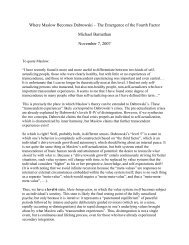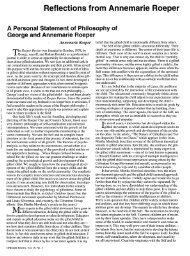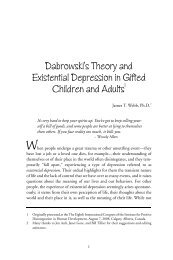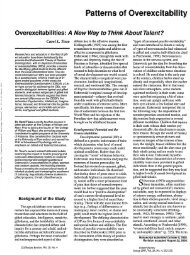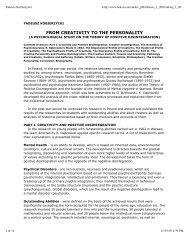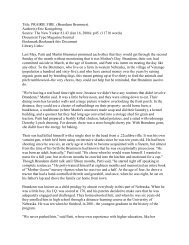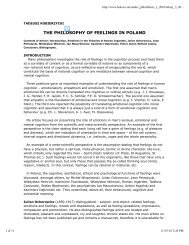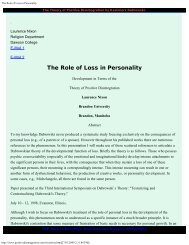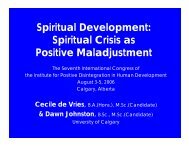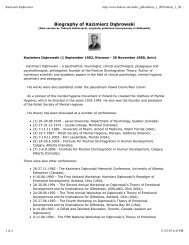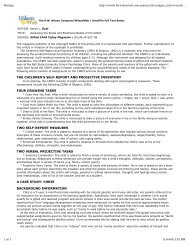Strategies Used by Intellectually Gifted Students to Cope With Stress ...
Strategies Used by Intellectually Gifted Students to Cope With Stress ...
Strategies Used by Intellectually Gifted Students to Cope With Stress ...
Create successful ePaper yourself
Turn your PDF publications into a flip-book with our unique Google optimized e-Paper software.
132 <strong>Gifted</strong> Child Quarterly 54(2)<br />
Table 3. Frequency <strong>Students</strong> <strong>Used</strong> Coping <strong>Strategies</strong> Assessed via the ACOPE<br />
High-Achieving Tests of Between- Effect<br />
<strong>Gifted</strong> IB (n = 52) IB (n = 89) Group Differences Size<br />
Coping Strategy M SD M SD t p d<br />
Positive appraisal 3.22 0.93 3.33 0.70 0.77 .44 .15<br />
Family communication 2.87 0.73 3.01 0.78 1.08 .28 .19<br />
Negative avoidance 1.21 0.35 1.22 0.35 0.20 .84 .04<br />
Anger 2.99 0.79 2.70 0.68 -2.26 .03 .39<br />
Note: ACOPE = Adolescent Coping Orientation for Problem Experiences; IB = International Baccalaureate.<br />
Table 4. Frequency <strong>With</strong> Which Each Coping Strategy That Was Described as Employed or Effective Was Mentioned <strong>With</strong>in Each Group<br />
of <strong>Students</strong> <strong>With</strong>in IB<br />
High Achieving<br />
<strong>Gifted</strong> (n = 22) (n = 26) Total (N = 48)<br />
Coping Strategy n Percentage n Percentage n Percentage<br />
1. Taking deliberate action steps <strong>to</strong> address problems 51 100 69 100 120 100<br />
Managing tasks 28 100 41 100 69 100<br />
Focusing efforts and energy on enacting plan 16 100 7 75 23 88<br />
Managing time 7 75 11 75 18 75<br />
Decision making relevant <strong>to</strong> demands 0 0 10 100 10 50<br />
2. Avoiding demands 67 100 43 100 92 110<br />
Engaging in activities unrelated <strong>to</strong> problem 47 100 24 100 71 100<br />
Procrastinating 16 100 15 100 31 100<br />
Fixating on problem without taking action 4 50 4 75 8 63<br />
3. Seeking social support from people within immediate environment 28 100 27 100 55 100<br />
Seeking social support from IB classmates 7 75 7 75 14 75<br />
Placing problems in perspective 12 75 9 75 21 75<br />
Seeking social support from family members 9 75 11 75 20 75<br />
4. Giving self permission <strong>to</strong> feel positive emotions 16 100 23 100 39 100<br />
Engaging in relaxing activity 9 100 23 100 32 100<br />
Laughing and maintaining a sense of humor 7 50 0 0 7 25<br />
5. Maintaining relationships with people outside of immediate environment 13 75 17 75 30 75<br />
Seeking social support from non-IB peers 13 75 5 50 18 63<br />
Investing in close friends 0 0 12 75 12 38<br />
6. Sleeping 13 100 14 75 27 88<br />
7. Reducing workload 15 100 6 75 21 88<br />
Renegotiating expectations, activities, deadlines 11 100 3 50 14 75<br />
Divvying up assignments with classmates 4 50 3 25 7 38<br />
8. Be alone 3 50 5 75 8 63<br />
Note: IB = International Baccalaureate; n = number of times strategy mentioned in each group; percentage = proportion of groups in which the strategy<br />
was mentioned at least one time.<br />
Traditional inven<strong>to</strong>ry of adolescent coping styles. The mean<br />
frequency with which the two groups of students (gifted and<br />
high-achieving IB) reported using each of the coping styles<br />
assessed <strong>by</strong> the ACOPE was compared via a series of t-tests.<br />
Since multiple (i.e., four) tests were conducted, the significance<br />
level was adjusted via a Bonferroni correction in order<br />
<strong>to</strong> control for experiment-wise probability of making a Type<br />
I error, resulting in a revised alpha of .0125. As shown in<br />
Table 3, the two groups of students reported similar use of<br />
positive appraisal, negative avoidance, and family communication<br />
strategies <strong>to</strong> cope with stressors. Although there was a<br />
trend for gifted students <strong>to</strong> report employing angry behaviors<br />
(e.g., become sarcastic, complain, yell) more often in times<br />
of stress, the difference between groups was not statistically<br />
significant when the conservative alpha level was employed.<br />
Because the relatively small sample sizes and conservative<br />
alpha increases the likelihood of researchers failing <strong>to</strong> identify<br />
an effect of group even in the event that a true effect<br />
exists, effect sizes were calculated <strong>to</strong> provide additional<br />
information about the reliability of differences in coping<br />
behaviors between groups. According <strong>to</strong> Cohen’s (1992)<br />
guidelines for interpreting effect sizes, the magnitude of the<br />
between-group differences with respect <strong>to</strong> frequency of use<br />
of anger coping strategies is small, suggesting that gifted and<br />
Downloaded from gcq.sagepub.com at UNIV CALGARY LIBRARY on March 4, 2011



